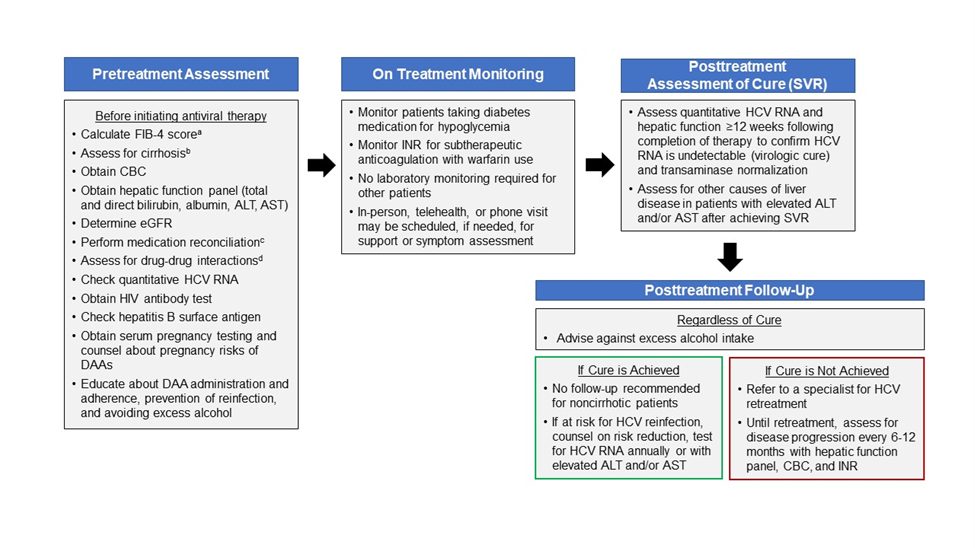Who Is NOT Eligible for Simplified Treatment (Without Cirrhosis) |
|---|
Patients who have any of the following characteristics:
(see Resource Library for treatment recommendations for these patients) |
Who Is Eligible for Simplified Treatment |
|---|
| Adults with chronic hepatitis C (any genotype) who do not have cirrhosis and have not previously received hepatitis C treatment |
- Calculate FIB-4 score
- Cirrhosis assessment: Liver biopsy is not required. For the purpose of this guidance, a patient is presumed to have cirrhosis if they have a FIB-4 score >3.25 or any of the following findings from a previously performed test
- Transient elastography indicating cirrhosis (eg, FibroScan stiffness >12.5 kPa)
- Noninvasive serologic tests above proprietary cutoffs indicating cirrhosis (eg, FibroSure, Enhanced Liver Fibrosis Test, etc)
- Clinical evidence of cirrhosis (eg, liver nodularity and/or splenomegaly on imaging, platelet count <150,000/mm3, etc)
- Prior liver biopsy showing cirrhosis
- Medication reconciliation: Record current medications, including over-the-counter drugs and herbal/dietary supplements
- Potential drug-drug interaction assessment: Drug-drug interactions can be assessed using the AASLD/IDSA guidance or the University of Liverpool drug interaction checker
- Drug-drug interactions are particularly important in HIV co-infection
- In those with HIV, the simplified treatment approach should not be used in those on TDF containing regimens with eGFR <60 ml/min because of the need of additional monitoring
- Education: Educate the patient about proper administration of medications, adherence, and prevention of reinfection
- Pretreatment laboratory testing:
- Within 6 months of initiating treatment:
- Complete blood count (CBC)
- Hepatic function panel (ie, albumin, total and direct bilirubin, alanine aminotransferase [ALT], aspartate aminotransferase [AST])
- Calculated glomerular filtration rate (eGFR)
- Any time prior to starting antiviral therapy:
- Quantitative HCV RNA (HCV viral load)
- HIV antigen/antibody test
- Hepatitis B surface antigen
- Before initiating antiviral therapy:
- Serum pregnancy testing and counseling about pregnancy risks of HCV medication should be offered to women of childbearing age
- Within 6 months of initiating treatment:
- Glecaprevir (300 mg)/pibrentasvir (120 mg) to be taken with food for a duration of 8 weeks
- Sofosbuvir (400 mg)/velpatasvir (100 mg) for a duration of 12 weeks
- Inform patients taking diabetes medication of the potential for symptomatic hypoglycemia. Monitoring for hypoglycemia is recommended
- Inform patients taking warfarin of the potential for changes in their anticoagulation status. Monitoring INR for subtherapeutic anticoagulation is recommended
- No laboratory monitoring is required for other patients
- An in-person or telehealth/phone visit may be scheduled, if needed, for patient support, assessment of symptoms, and/or new medications
- Assessment of quantitative HCV RNA and a hepatic function panel are recommended 12 weeks or later following completion of therapy to confirm HCV RNA is undetectable (virologic cure) and transaminase normalization
- Assessment for other causes of liver disease is recommended for patients with elevated transaminase levels after achieving SVR
- No liver-related follow-up is recommended for noncirrhotic patients who achieve SVR
- Patients with ongoing risk for HCV infection (eg, intravenous drug use or MSM engaging in unprotected sex) should be counseled about risk reduction, and tested for HCV RNA annually and whenever they develop elevated ALT, AST, or bilirubin
- Advise patients to avoid excess alcohol use
- Patients in whom initial HCV treatment fails to achieve cure (SVR) should be evaluated for retreatment by a specialist, in accordance with AASLD/IDSA guidance
- Until retreatment occurs, assessment for disease progression every 6 to 12 months with a hepatic function panel, CBC, and INR is recommended
- Advise patients to avoid excess alcohol use
*More detailed descriptions of the patient evaluation process and antivirals used for HCV treatment, including the treatment of patients with cirrhosis, can be found here

| a FIB-4 is a noninvasive measure of hepatic fibrosis that is calculated by: (age [years] x AST [U/L]) ÷ (platelet count [109/L]) x (ALT1/2 [U/L])).b A patient is presumed to have cirrhosis if they have a FIB-4 score >3.25 or if they any of the following from a previously performed test: (1) transient elastography indicating cirrhosis (ie, liver stiffness >12.5 kPa); (2) noninvasive serologic test above the proprietary cutoff indicating cirrhosis (eg, FibroSure, Enhanced Liver Fibrosis Test); (3) clinical evidence of cirrhosis (eg, liver nodularity and/or splenomegaly on imaging, platelet count <150,000/mm3</sup>); or (4) prior liver biopsy showing cirrhosis.
c Medication reconciliation should record currently prescribed medications, over-the-counter drugs, and herbal/dietary supplements. d Drug-drug interaction assessment should be performed using the table in the monitoring section of the HCV guidance website or the University of Liverpool drug interaction checker. |